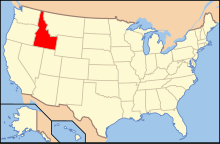
Paleontology in Idaho refers to paleontological research occurring within or conducted by people from the U.S. state of Idaho. The fossil record of Idaho spans much of the geologic column from the Precambrian onward.[1] During the Precambrian, bacteria formed stromatolites while worms left behind trace fossils. The state was mostly covered by a shallow sea during the majority of the Paleozoic era. This sea became home to creatures like brachiopods, corals and trilobites. Idaho continued to be a largely marine environment through the Triassic and Jurassic periods of the Mesozoic era, when brachiopods, bryozoans, corals, ichthyosaurs and sharks inhabited the local waters. The eastern part of the state was dry land during the ensuing Cretaceous period when dinosaurs roamed the area and trees grew which would later form petrified wood.
Cenozoic Idaho had a more hospitable climate than it does today and would come to be home to huge forests and creatures like camels, early horses, mastodons, and sloths. During the Pleistocene, short-faced bears, bison, camels, mammoths, saber-toothed cats, and giant sloths inhabited the state. By the dawn of the 20th century, the state's fossils had come to the attention of formally trained scientists. Major local finds include the 1904 discovery of multiple mammoth skeletons and the 1928 discovery of a Pliocene bonebed. The Pliocene Hagerman horse, Equus simplicidens, is the Idaho state fossil.